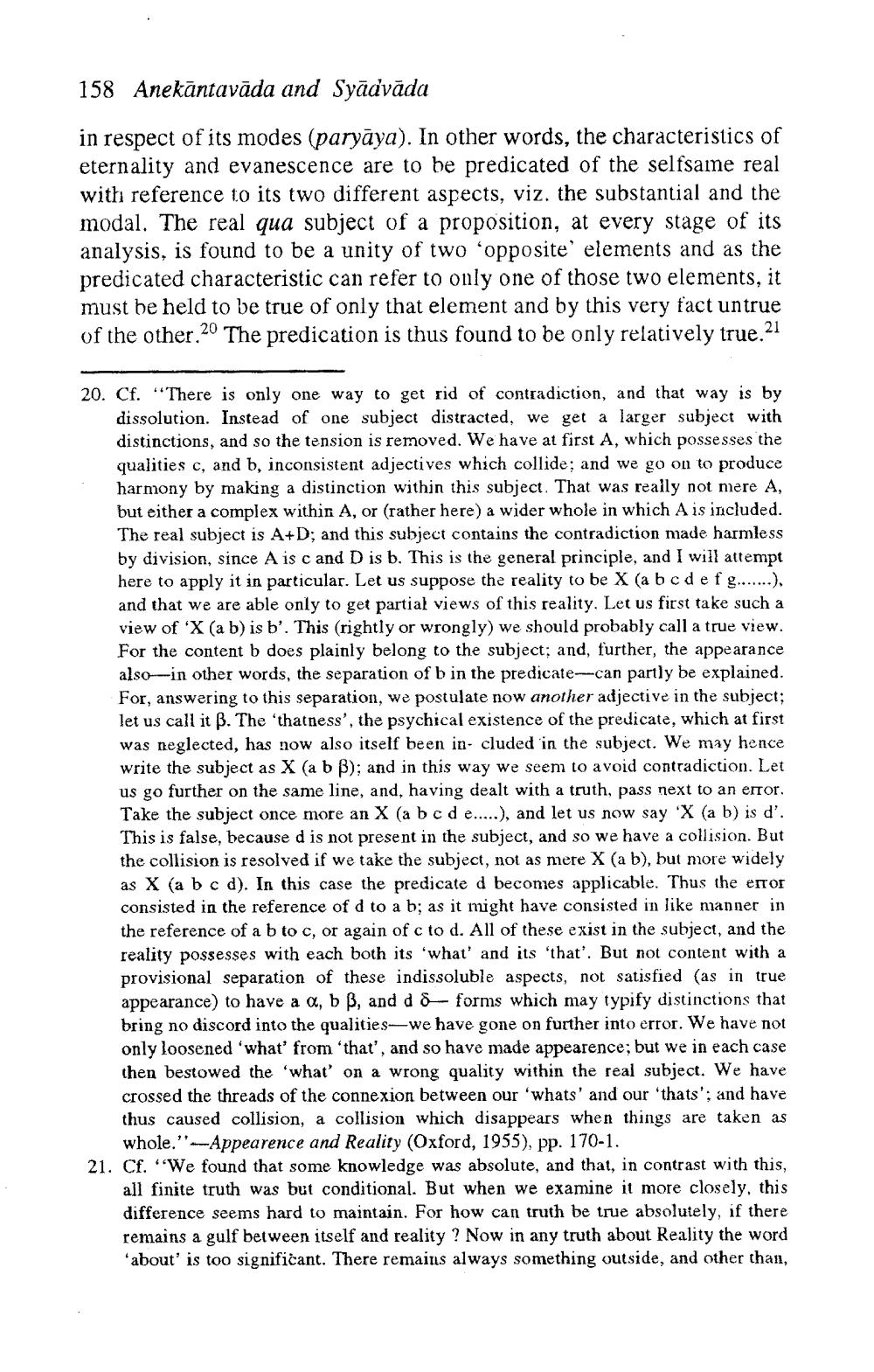________________
158 Anekāntavāda and Syāavāda
in respect of its modes (paryāya). In other words, the characteristics of eternality and evanescence are to be predicated of the selfsame real with reference to its two different aspects, viz. the substantial and the modal. The real qua subject of a proposition, at every stage of its analysis, is found to be a unity of two 'opposite' elements and as the predicated characteristic can refer to only one of those two elements, it must be held to be true of only that element and by this very fact untrue of the other.20 The predication is thus found to be only relatively true.21
20. Cf. “There is only one way to get rid of contradiction, and that way is by
dissolution. Instead of one subject distracted, we get a larger subject with distinctions, and so the tension is removed. We have at first A, which possesses the qualities c, and b, inconsistent adjectives which collide; and we go on to produce harmony by making a distinction within this subject. That was really not mere A, but either a complex within A, or (rather here) a wider whole in which A is included. The real subject is A+D; and this subject contains the contradiction made harmless by division, since A is c and D is b. This is the general principle, and I will attempt here to apply it in particular. Let us suppose the reality to be X (a bcdefg.......), and that we are able only to get partial views of this reality. Let us first take such a view of 'X (a b) is b'. This (rightly or wrongly) we should probably call a true view. For the content b does plainly belong to the subject; and, further, the appearance also--in other words, the separation of b in the predicate-can partly be explained. For, answering to this separation, we postulate now another adjective in the subject; let us call it B. The 'thatness', the psychical existence of the predicate, which at first was neglected, has now also itself been in- cluded in the subject. We may hence write the subject as X (a b B); and in this way we seem to avoid contradiction. Let us go further on the same line, and, having dealt with a truth, pass next to an error. Take the subject once more an X (a b c d e.....), and let us now say 'X (a b) is d'. This is false, because d is not present in the subject, and so we have a collision. But the collision is resolved if we take the subject, not as mere X (a b), but more widely as X (a b c d). In this case the predicate d becomes applicable. Thus the error consisted in the reference of d to a b; as it might have consisted in like manner in the reference of a b to c, or again of c to d. All of these exist in the subject, and the reality possesses with each both its 'what' and its 'that'. But not content with a provisional separation of these indissoluble aspects, not satisfied (as in true appearance) to have a a, b B, and d & forms which may typify distinctions that bring no discord into the qualities we have gone on further into error. We have not only loosened 'what' from that', and so have made appearence; but we in each case then bestowed the 'what' on a wrong quality within the real subject. We have crossed the threads of the connexion between our 'whats' and our 'thats'; and have thus caused collision, a collision which disappears when things are taken as
whole." --Appearence and Reality (Oxford, 1955), pp. 170-1. 21. Cf. "We found that some knowledge was absolute, and that, in contrast with this,
all finite truth was but conditional. But when we examine it more closely, this difference seems hard to maintain. For how can truth be true absolutely, if there remains a gulf between itself and reality ? Now in any truth about Reality the word 'about' is too significant. There remains always something outside, and other than,




